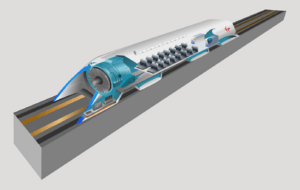Hyperloop facts for kids
A Hyperloop is a new type of train that people hope will travel super fast. It's designed to move inside a special tube where there's almost no air. Because there's no air, there's very little friction to slow it down. This allows the Hyperloop to reach amazing speeds!
Engineers and companies are working on and testing Hyperloop technology in many places around the world. You can find projects in the United States, the Middle East, and Asia.
The idea for the Hyperloop was first shared in 2012 by Elon Musk. He is famous for companies like Tesla and SpaceX. In 2013, he put a detailed plan online. This plan showed a Hyperloop train that could travel between San Francisco and Los Angeles in the United States in just 35 minutes! He made this technology "open source," meaning anyone could use and improve his ideas.
In 2015, one of Musk's companies built a test tube about 1.6 kilometres (0.99 miles) long. He then invited universities and other companies to build their own test trains, called "pods." They held two competitions in 2017 to see which pod could go the fastest. The quickest test pod reached a speed of 324 kilometres per hour (201 miles per hour)!
What's Good About Hyperloop?
- Super Fast Travel: The Hyperloop will be much faster than cars, buses, or regular trains. Elon Musk thinks it could travel over 700 kilometres per hour (430 miles per hour)! Imagine getting to places so quickly.
- Good for the Planet: Most plans for Hyperloop systems aim to be eco-friendly. They often suggest using solar power to run the entire system. This means less pollution compared to many current ways of traveling.
- Open for Everyone: The Hyperloop is an "open-source" technology. Elon Musk shared all the plans online for free. This means anyone can use the ideas and help make the technology even better.
- No Weather Worries: Since Hyperloop trains run inside sealed tubes, they won't be affected by bad weather. Snow, fog, or heavy rain won't stop them from running on time.
What Are the Challenges?
- Very High Cost: Building a Hyperloop system will likely be very expensive. For example, the Hyperloop from Los Angeles to San Francisco is predicted to cost between 6 and 7.5 billion US dollars.
- Passenger Comfort: Traveling at such high speeds inside a tube might cause problems for some passengers. The ride could vibrate, which might make people feel dizzy or sick to their stomach.
- Limited Movement: Passengers won't be able to move around much while the Hyperloop is traveling. Just like on some fast city trains, there won't be access to toilets during the trips.
Images for kids
See also
 In Spanish: Hyperloop para niños
In Spanish: Hyperloop para niños





